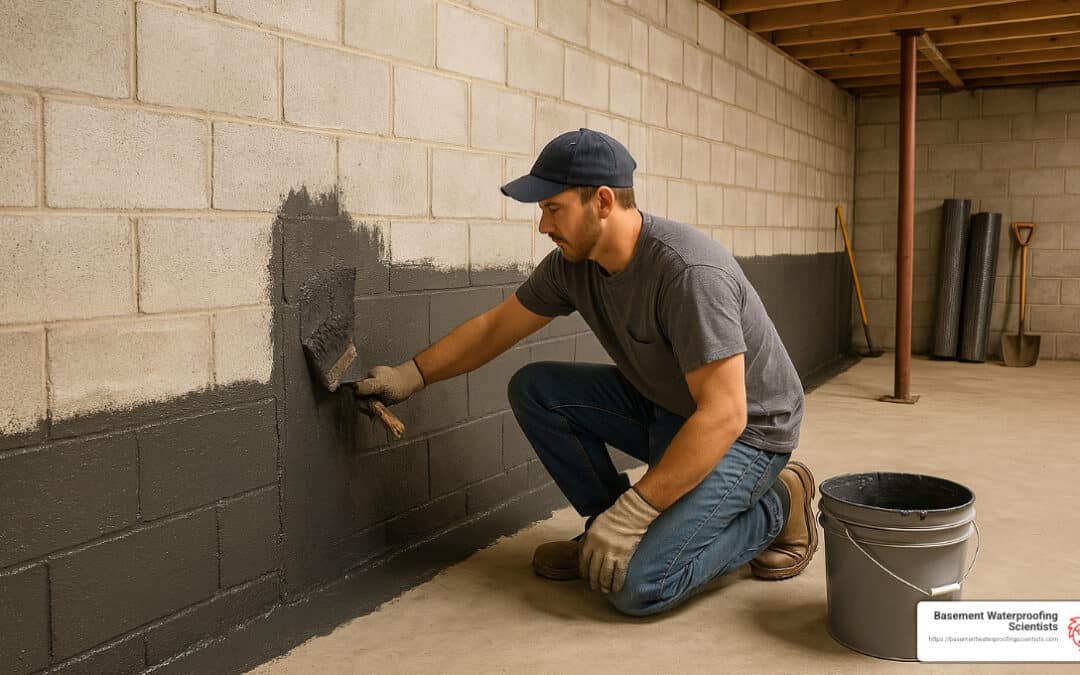Protecting Your Home’s Foundation from Moisture Damage
Basement and crawlspace waterproofing is the process of preventing water from entering the below-grade areas of your home through comprehensive moisture control solutions. If you’re looking for quick guidance on waterproofing your basement or crawlspace, here’s what you need to know:
|
Waterproofing Approach |
Best For |
Average Cost |
|---|---|---|
|
Interior Waterproofing |
Existing water issues, budget constraints |
$2,000-$6,000 |
|
Exterior Waterproofing |
New construction, severe water problems |
$8,000-$15,000 |
|
Crawlspace Encapsulation |
Humidity control, energy efficiency |
$3,000-$7,000 |
|
Drainage Systems |
Managing water flow away from foundation |
$1,000-$5,000 |
Water intrusion in your basement or crawlspace isn’t just an inconvenience—it’s a serious threat to your home’s structural integrity, indoor air quality, and your family’s health. Left untreated, moisture problems can lead to mold growth, wood rot, pest infestations, and even foundation failure.
The average cost for comprehensive basement waterproofing ranges between $4K and $8K, depending on the size of your space, severity of water issues, and methods used. While this may seem like a significant investment, it’s far less expensive than repairing major structural damage or dealing with recurring mold remediation. It is crucial to hire a qualified contractor to properly assess and address issues such as drainage, mold, and insulation before encapsulation begins.
Signs your basement or crawlspace needs waterproofing include:
-
Standing water or dampness after rain
-
Musty odors or visible mold growth
-
White powdery residue (efflorescence) on walls
-
Peeling paint or crumbling concrete
-
Warped wooden structures or floors
-
High indoor humidity levels
As Darin Garvey, I’ve spent over 15 years implementing effective basement and crawlspace waterproofing solutions throughout Philadelphia, helping homeowners transform damp, problematic spaces into dry, usable areas of their homes. My team at Basement Waterproofing Scientists specializes in customized approaches that address the unique challenges of each property.
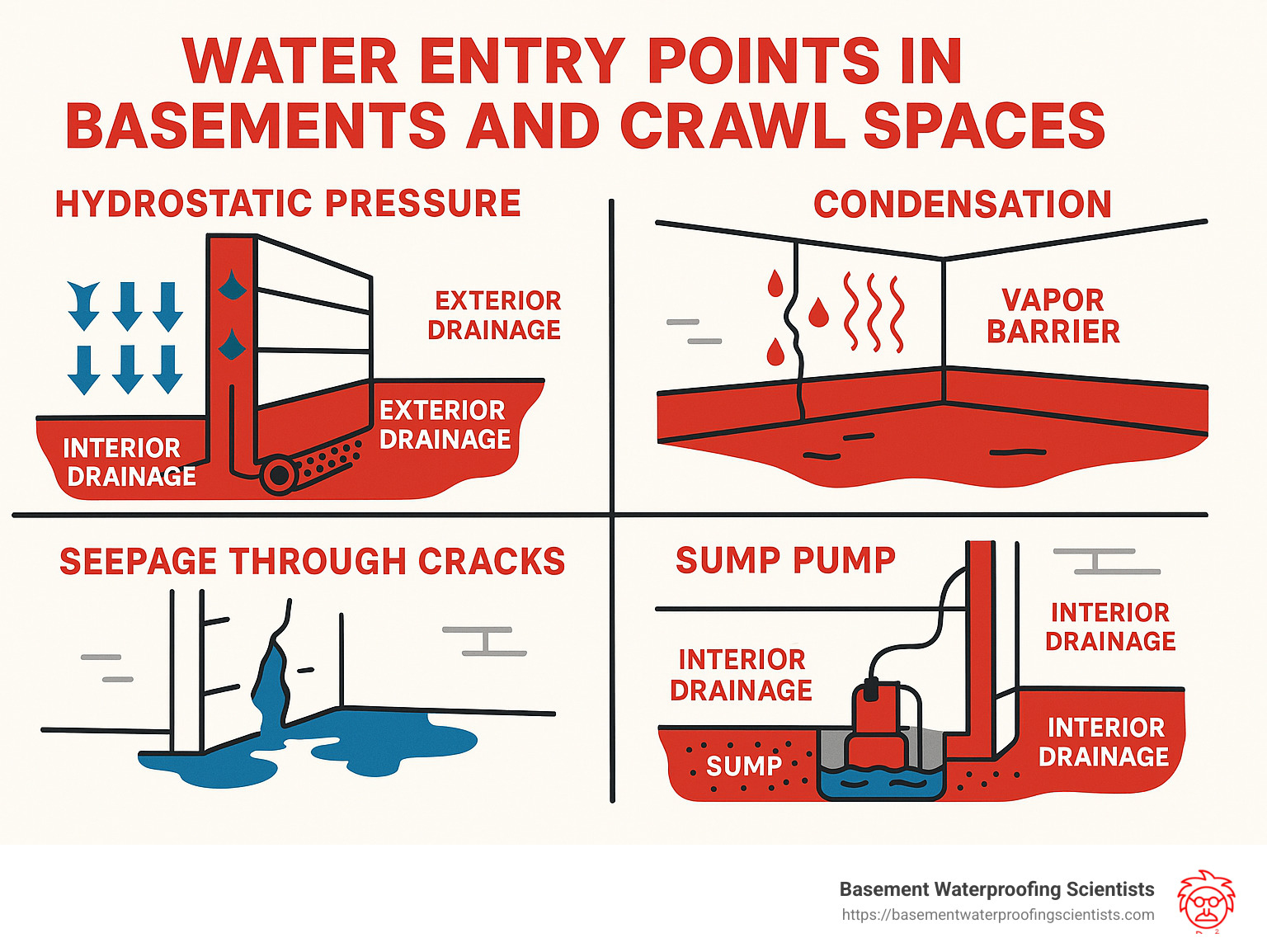
Understanding the Need for Basement and Crawlspace Waterproofing
If you’ve ever noticed mysterious puddles or a musty smell in your basement or crawl space, you know how puzzling—and frustrating—it can be. At Basement Waterproofing Scientists, we’ve spent more than 30 years helping homeowners understand exactly why these moisture problems happen and, more importantly, what you can do about them. When it comes to your home, knowledge really is power (and dryness).
The Science Behind Water Intrusion
Water has an annoying habit of finding every tiny crack and opening around your basement or crawlspace. The primary reason behind this persistent invasion is something called hydrostatic pressure. Sounds fancy, right? But it’s actually pretty simple: as water gathers in the soil around your home, it pushes against your foundation walls. This constant pressure can force moisture through the smallest openings, cracks, or even directly through porous concrete.
One of our clients in King of Prussia put it perfectly after we explained it to him: “I couldn’t understand why my basement kept getting damp, even with just a bit of rain. Once you explained hydrostatic pressure, it suddenly clicked—water wasn’t just dripping in; it was literally being pressed through the walls.”
Hydrostatic pressure isn’t the only way water finds its way in. Other common culprits include groundwater seepage, where water naturally moves downhill toward your home, and poor drainage around your property, including inadequate gutters, downspouts, or improper grading. Water can seep into your foundation, leading to moisture problems. Even smaller issues like condensation—which forms when warm, humid air meets cool basement surfaces—or those pesky plumbing leaks can lead to significant moisture problems over time.
If you’re interested in digging deeper into the science, check out this insightful article from Energy Star on moisture control in basements and crawlspaces.
The Domino Effect of Moisture Problems
When moisture enters your basement or crawlspace, you’re not just dealing with an annoying mess; you’re setting off a chain reaction of moisture problems and moisture related issues throughout your home.
First, moisture can cause structural damage—weakening concrete walls, corroding metal supports, and rotting wooden beams or floors. Mold and mildew love damp environments, and they can begin growing within just 24 to 48 hours after a moisture event. This mold growth isn’t just unsightly; it significantly reduces your home’s air quality. Did you know up to half of the air you breathe upstairs actually originates in your basement or crawlspace? Yep, that’s why that musty basement smell tends to creep into your living spaces.
Then there are the hidden costs you might not immediately consider. Damp air makes your HVAC system work harder, driving up your energy bills. According to Energy Star research, heat loss through uninsulated basement walls can account for up to one-third of total heat loss in an average home. And let’s not forget that damp environments attract all sorts of unwanted guests—pest infestations from insects and rodents who thrive in moisture-rich conditions.
The Long-Term Value of Waterproofing
In our decades of serving homeowners throughout Pennsylvania, New Jersey, and Delaware, we’ve consistently seen the real benefits of investing in professional basement and crawlspace waterproofing. When you waterproof properly, you don’t just prevent water damage—you’re investing in your home’s future and your family’s wellbeing.
A well-waterproofed basement or crawlspace helps you:
-
Avoid costly repairs to foundations, support beams, and flooring
-
Eliminate repeated mold remediation costs
-
Lower your monthly energy bills by enhancing your home’s energy efficiency
-
Increase your usable living space—turning once-damp areas into dry, comfortable rooms
-
Boost your property value and overall home comfort
Waterproofing significantly improves the quality of life for homeowners by ensuring their home remains a safe and healthy sanctuary.
One Norristown homeowner summed it up perfectly after we waterproofed his basement: “It’s not just that my basement is finally dry—my whole house feels healthier. The air is cleaner, my allergies improved, and even my heating bills have dropped. My only regret is that I didn’t do this sooner.”
At Basement Waterproofing Scientists, we understand that waterproofing can feel like a big step, both financially and emotionally. But the peace of mind you gain—and the long-term benefits for your home and family—make it one of the smartest home improvement moves you can make.
Signs Your Basement or Crawlspace Needs Waterproofing
Recognizing moisture issues in your basement or crawlspace early can save you a ton of headaches (and cash) down the road. At Basement Waterproofing Scientists, we’ve been helping Pennsylvania homeowners spot these early indicators before they balloon into costly repairs. Trust us—catching the problem early always beats dealing with structural nightmares down the line.
-
Musty or Unpleasant Odors: Musty or unpleasant odors are often a consequence of mold and mildew growth due to excess humidity. These odors, along with health issues such as allergies and respiratory problems, are significant reasons to prioritize waterproofing and moisture control in your home.
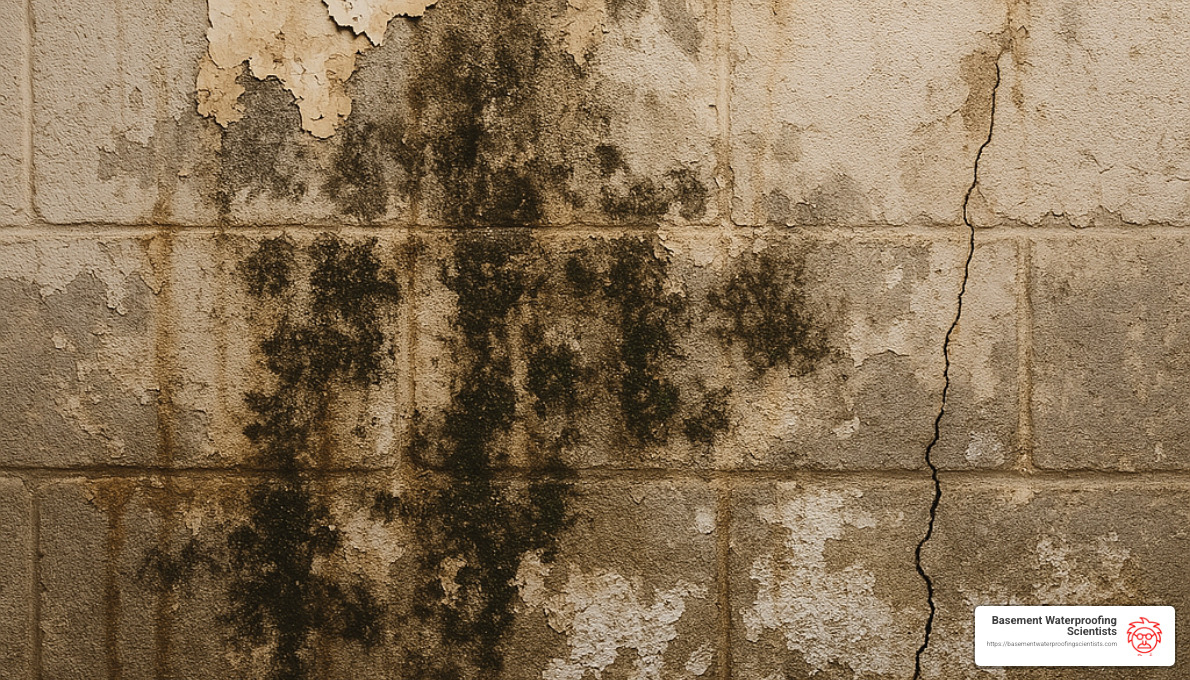
Visual Indicators of Moisture Problems
Sometimes, your eyes are your best tool for detecting basement or crawlspace moisture issues early. When you’re checking around your home, keep an eye out for key warning signs like standing water (puddles or moisture accumulation after rain). It might seem obvious, but you’d be surprised how many homeowners overlook this at first glance.
Another clear clue is water stains on walls, floors, or ceilings. These stains usually mean water has seeped through before and might continue doing so. Pay special attention to crawl space walls, as waterproofing these walls, along with the floor and vents, creates a protective envelope that keeps moisture out and protects the home’s mechanical systems from humidity and other outdoor elements. Likewise, if you spot a white, chalky powder called efflorescence on concrete or masonry surfaces, it’s a solid indicator of evaporated water leaving minerals behind—a clear sign of moisture intrusion.
Moisture also affects paint and wallpaper. If you notice peeling, bubbling, or flaking paint, chances are moisture is lurking beneath. Metal objects or stored items showing rust point to excessive humidity, as moisture in the air corrodes these surfaces.
If your basement or crawlspace insulation looks saggy, discolored, or ineffective, moisture might be ruining it. Keep an eye out for visible mold or mildew—those greenish-black patches lurking in corners or near floor joints. Mold loves dampness and may start growing quickly once moisture appears.
Wood structures aren’t safe either—moisture can quickly trigger rotting wood, damaging structural beams, wooden shelves, or trim. And speaking of structures: look carefully at your foundation walls for cracks, especially horizontal ones, and pay attention if they look bowed or bulging. Those signs usually mean hydrostatic pressure—water pushing through the soil—is putting serious strain on your home’s foundation.
A homeowner from Lansdale once shared with us: “I spotted small water stains in my basement and figured they were minor. By the time I called Basement Waterproofing Scientists, those ‘minor’ stains had turned into a major structural repair costing triple what early waterproofing would have.”
Sensory Warning Signs
Sometimes, your eyes alone can’t detect moisture issues—but your other senses can help. Ever walked into a basement or crawlspace and immediately noticed that musty, damp basement smell? That’s usually mold or mildew growing somewhere hidden from sight.
Pay attention to the humidity level as well. If walking into your basement or crawlspace leaves you feeling sticky or clammy, it’s a sure sign there’s too much moisture in the air. High humidity can lead to mold growth, pest infestations, and even structural damage. Additionally, if certain walls or floors feel unusually cold to the touch, this temperature difference might mean water infiltration is happening behind the scenes.
And don’t underestimate the power of sound. Listen carefully, particularly after rainfall, for dripping, trickling, or gurgling noises. These subtle sounds can often point directly to hidden leaks or water intrusion.
One of our Upper Darby Township clients, Peter L., summed it up perfectly: “My crawlspace used to have standing water, mold, fungus, wood rot, and an unbearable musty odor. That smell throughout my house was the first big clue something seriously wrong was going on.”
Above-Ground Signs of Below-Ground Problems
Interestingly, moisture issues below ground often show their effects upstairs, too. Hardwood floors suddenly buckling, warping, or swelling usually indicate moisture rising from your basement or crawlspace. Likewise, if mold starts appearing on your first-floor walls (particularly near the floor), the source might be moisture coming up from below.
You might also notice family members experiencing allergy flare-ups, asthma issues, or breathing discomfort that magically improves when they’re away from home. Persistent moisture in your basement or crawlspace often leads to poor indoor air quality, causing these health symptoms.
Another subtle symptom is doors and windows sticking or becoming difficult to open. Moisture can cause frames and wooden structures to swell, making things feel “off”. Lastly, don’t forget pests. Damp environments attract insects and rodents—another uninvited consequence of moisture intrusion.
As our lead technician often says, “Even small leaks can snowball into bigger issues over time. That’s why catching them early is key.” That’s precisely why we offer free home inspections throughout Pennsylvania, Delaware, and New Jersey: spotting issues early saves money, stress, and headaches down the line. Effective humidity solutions, such as using dehumidifiers and sealing home foundations, are crucial for managing moisture levels and preventing mold growth.
Try the Aluminum Foil Test
Still unsure if moisture is invading your basement or crawlspace? Here’s an easy DIY test:
-
Take a 12″x12″ square of aluminum foil and tape it firmly onto your basement wall.
-
Seal all four edges with tape to keep air out.
-
Leave it untouched for 24 hours, then carefully remove and inspect it:
-
If the side facing the wall is damp or wet, water is seeping through your foundation.
-
If the side facing the room is wet, your issue is condensation.
This quick test helps pinpoint what’s causing your moisture issues, allowing our waterproofing experts at Basement Waterproofing Scientists to recommend the most effective basement and crawlspace waterproofing solution for your unique situation.
Methods of Basement and Crawlspace Waterproofing
At Basement Waterproofing Scientists, we’ve spent over 30 years perfecting our approach to basement and crawlspace waterproofing. We know every home is unique, so each waterproofing solution needs to be custom to meet your specific situation. Let’s take a closer look at some of the most effective waterproofing methods to help you keep your basement or crawlspace dry, healthy, and worry-free. One such method is crawl space encapsulation, which is highly effective in eliminating unpleasant odors and moisture buildup.
Interior Basement and Crawlspace Waterproofing Solutions
Interior waterproofing methods handle water that’s already finding its way into your basement or crawlspace. Though these solutions may not tackle the original source of water intrusion, they’re typically more affordable and less disruptive, making them a popular choice for homeowners. Additionally, using spray foam insulation to seal and encapsulate crawl spaces can enhance moisture control and insulation performance by creating airtight seals around walls, floors, and vents.
Sealants and Coatings
Applying sealants and coatings to your foundation walls and floors creates a moisture barrier that blocks water entry. Some proven products we rely on include hydraulic cement, a fast-setting material that plugs leaks and cracks by expanding as it dries, and silicate-based concrete sealers, which soak into concrete to form a chemical moisture barrier. To cover larger areas, we often use acrylic waterproofing paint, creating a durable, water-resistant surface. For cracks, polyurethane injections expand to fill even the smallest gaps, sealing them against leaks.
After implementing these solutions for Jill K. in Bristol Township, she happily reported, “The customer service was incredible. My basement stayed completely dry—no more discoloration or water stains. I’m thrilled with their work!”
Interior Drainage Systems
Interior drainage methods effectively collect and direct water away from your home’s usable spaces. Interior perimeter drains installed right where your basement walls meet the floor efficiently capture water before it spreads. These drains are especially valuable if you experience consistent seepage from heavy rains. We also recommend drainage matting, a special dimpled sheet that channels water directly to the drain system, or channel drains for targeted collection in problem spots.
Sump Pump Systems
No waterproofing system is complete without an effective way to remove collected water—enter the trusty sump pump! A primary sump pump sits at the lowest point of your basement or crawlspace, typically within a sump pump basin, automatically pumping water safely outside your home. To ensure protection even during power outages, we install battery backup systems. For extra peace of mind, some homeowners choose water-powered backup pumps which rely on municipal water pressure, not electricity. Alarm systems can also alert you to any issues like pump failure or rising water levels.
One satisfied homeowner from Warminster Township joked after our installation: “My crawlspace was so clean and dry when these guys finished, I could practically sleep down there!”
Dehumidification and Air Quality Control
Properly controlling humidity levels is crucial in preventing mold and mildew growth. To achieve a truly comfortable, dry space, we recommend installing energy-efficient dehumidifiers that remove moisture from the air. Additionally, placing a thick vapor barrier on floors and walls will block ground moisture from rising into your home. Finally, ensuring adequate ventilation promotes healthy air circulation, reducing humidity even further. Modern energy-efficient homes may limit natural ventilation, potentially leading to humidity problems and indoor comfort concerns.
A homeowner in Radnor Township recently shared, “After Basement Waterproofing Scientists installed a specialized crawlspace dehumidifier, the musty smell vanished almost overnight. My allergies improved within days—I couldn’t be happier.”
Exterior Basement and Crawlspace Waterproofing Solutions
Exterior waterproofing tackles water issues at their source, preventing moisture from ever reaching your foundation. Although these solutions require more upfront investment and excavation, they provide the most complete and long-lasting protection for your home. Additionally, ensure that vents are not blocked to maintain proper airflow and prevent moisture buildup.
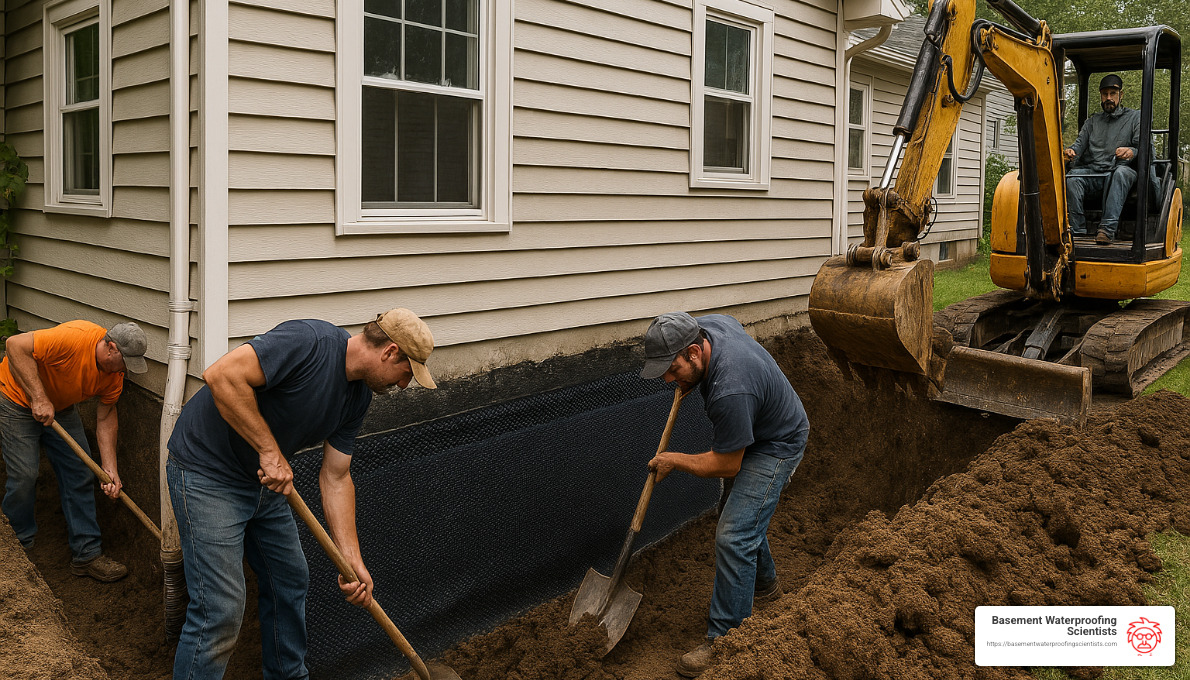
Excavation and Foundation Waterproofing
Exterior waterproofing involves carefully digging around your foundation walls to expose and properly seal them. After excavation, our technicians clean and prepare the walls, carefully sealing all cracks and applying a durable, flexible waterproof membrane. A protective board is then installed to shield this membrane as soil is replaced around your home.
Our lead engineer points out, “Exterior waterproofing is recognized by the International Building Code as the most effective method to prevent structural damage from water intrusion.” If your home has severe water issues, exterior waterproofing is often the best long-term solution.
Drainage Improvements
Proper drainage keeps water away from your foundation, preventing pressure buildup. To accomplish this, we install French drains, underground pipes surrounded by gravel that collect and redirect water. Footing drains, which sit at your foundation’s base, also capture groundwater before it has a chance to build pressure. Improving surface drainage through landscape features like swales, along with extending your gutter downspouts at least 10 feet away from the foundation, further reduces risks.
One happy client from Springfield Township told us, “After Basement Waterproofing Scientists corrected the grading around my house and extended my downspouts, my basement stayed dry through record-breaking rains for the first time in 15 years!”
Proper Grading and Landscaping
Landscape grading significantly influences your home’s waterproofing. Ideally, the ground around your foundation should slope gently (at least 6 inches over the first 10 feet) to naturally direct water away from your home. Strategic planting can also absorb excess moisture—rain gardens and plantings with high water requirements are attractive and functional solutions.
Crawlspace Encapsulation: A Comprehensive Waterproofing Approach
Crawlspaces are unique spaces that need special attention. At Basement Waterproofing Scientists, we often recommend encapsulation—a comprehensive method that completely seals your crawlspace from moisture and outside air. Experts like Crawl Space Ninja are renowned for their meticulous work in encapsulation, ensuring improved home health and efficiency.
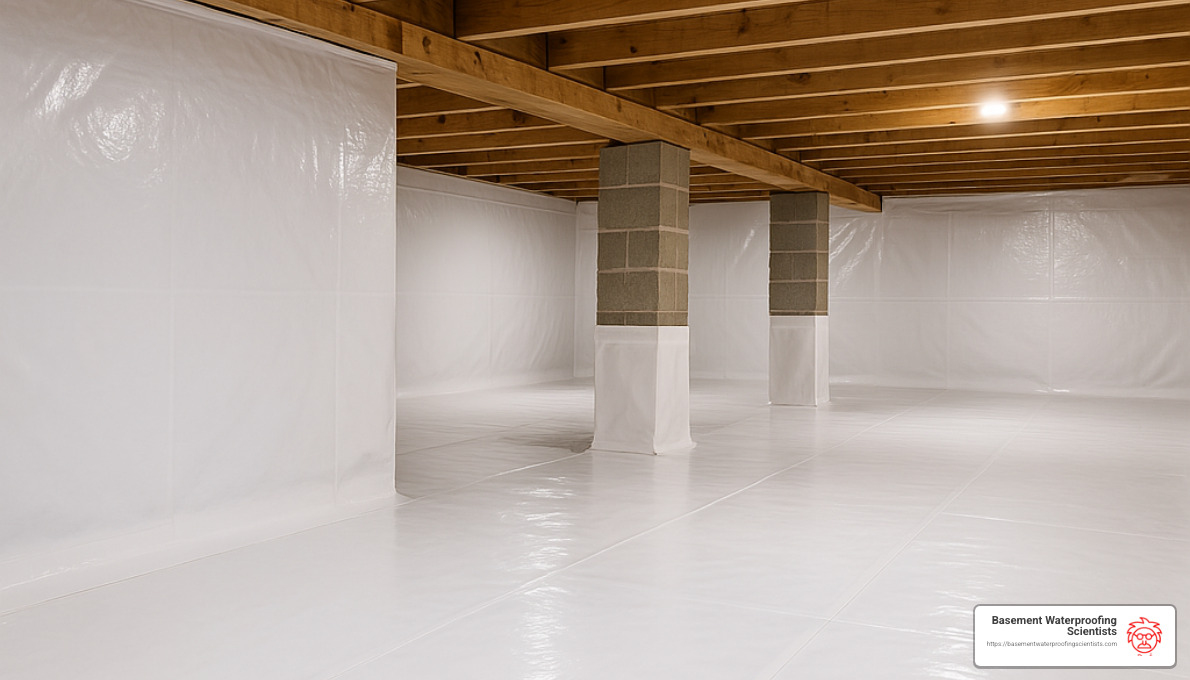
The Encapsulation Process
Encapsulation begins with a thorough cleanup, removing all debris, old insulation, and organic materials. If drainage issues exist, we address them first by installing interior drains and a sump pump. Next, we seal vents and other openings to prevent moist outside air from entering.
A thick, durable heavy-duty vapor barrier (around 20 mils thick, similar to a pool liner) is installed over the floor and walls, creating an airtight moisture barrier. Seams are securely sealed, and the barrier is fastened tightly to walls. Finally, an energy-efficient dehumidifier is installed to maintain ideal humidity levels.
Ashley H. from Willow Grove experienced an immediate change: “Basement Waterproofing Scientists made the encapsulation process stress-free. Our damp, musty crawlspace is now clean, dry, and usable.”
Benefits of Crawlspace Encapsulation
Encapsulation offers multiple benefits: it blocks up to 99% of moisture vapor, significantly improving indoor air quality. It also reduces energy bills by approximately 15-25%, prevents pests and insects, and creates valuable dry storage space. Most importantly, encapsulation protects structural elements like wooden floor joists from rot.
Building science experts agree—crawlspace encapsulation is the top recommended solution for moisture control, especially in humid climates like southeastern Pennsylvania.
Special Considerations for Crawlspaces
Crawlspaces present unique challenges due to limited access, dirt floors, and height restrictions. At Basement Waterproofing Scientists, we’ve developed specialized strategies to overcome these challenges, turning even the tightest, dampest crawlspaces into dry, healthy areas homeowners like you can depend on.
To learn more about the encapsulation process, visit our page on Crawlspace Waterproofing Encapsulation.
DIY vs. Professional Waterproofing: What’s Right for You?
When homeowners find moisture issues in their basements or crawlspaces, the first question is often: “Should I fix this myself or hire a professional?” At Basement Waterproofing Scientists, we get this question a lot. As experts with over 30 years of experience, we believe in providing honest, transparent guidance to help you make the best choice for your home—and your budget.
DIY waterproofing can be limited in addressing complex issues such as drainage, mold, and insulation. Therefore, hiring a qualified contractor is crucial to properly assess and address these problems before encapsulation begins.
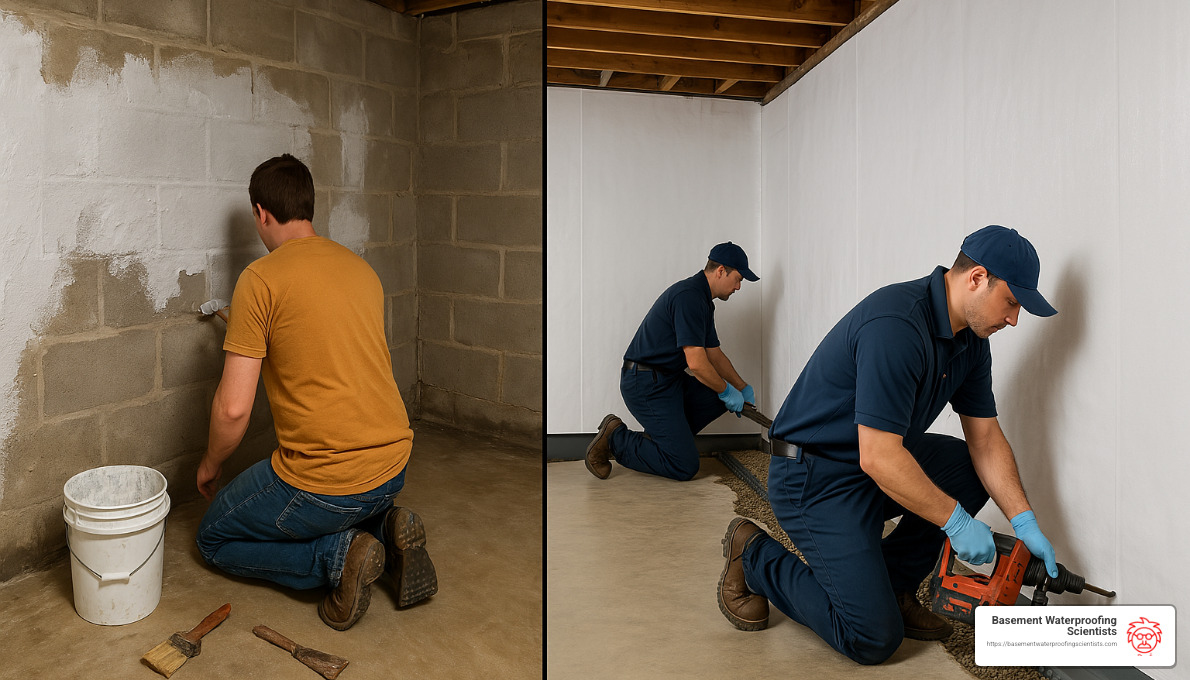
When DIY Waterproofing Makes Sense
Let’s start with the good news: some moisture issues can be effectively managed with DIY approaches. If the problem is minor, isolated, or related to basic maintenance, handling it yourself could be a practical solution.
For example, small cracks in foundation walls or floors can often be sealed with simple DIY products like hydraulic cement or polyurethane crack injections. Likewise, if you’re experiencing condensation issues, simply installing a properly sized dehumidifier can significantly reduce moisture and prevent mold growth.
Additionally, homeowners can typically handle small drainage improvements around their foundation. Tasks like grading soil away from your home to encourage proper water runoff, or regular gutter maintenance—cleaning debris and extending downspouts at least 10 feet from your foundation—are straightforward DIY projects that can have big payoffs.
As our technical director likes to say, “If you spot easy-to-fix leaks or drainage problems, give DIY a shot first. If the issue persists or gets worse, it’s probably time to call in the pros.” And remember, we’re always happy to offer free phone consultations to guide you through simple fixes.
Limitations of DIY Waterproofing
While DIY solutions have their place, recognize their limitations. The most significant drawback is that DIY methods often only treat surface symptoms, rather than addressing the root cause of the moisture intrusion.
Additionally, consumer-grade waterproofing products are generally less durable and effective than commercial-grade professional products. Without professional-grade sealants, membranes, or drainage systems, DIY solutions may only provide a temporary fix.
Another common challenge homeowners face is accurately diagnosing the source of water intrusion. Identifying hidden leaks, groundwater problems, or hydrostatic pressure issues can be nearly impossible without specialized equipment. And if the DIY fix doesn’t fully address the underlying issue, you risk continued water damage and escalating repair costs.
Safety is another major concern. Waterproofing work can involve excavation, handling electrical sump pump components, or working in confined crawlspaces—not exactly safe weekend projects for most homeowners. Finally, DIY solutions usually don’t come with warranties, meaning you’re on your own if something goes wrong.
One of our recent customers in Haverford Township learned this the hard way. After spending two years applying waterproofing paints and sealants to his basement walls, he finally called us. Our team quickly finded that hydrostatic pressure—not surface leaks—was behind his problem. Once we installed a professional drainage system, his basement stayed dry permanently. As he told us afterward, “I wish I’d called you first—I would have saved myself a lot of money and headaches.”
When Professional Waterproofing Is Necessary
For complex or persistent moisture problems, hiring a professional waterproofing specialist is strongly recommended. If you’re facing any of the following scenarios, professional intervention is likely your best bet:
Structural issues such as bowing walls, significant foundation cracks, or foundation settling can threaten your home’s integrity and require expert repair. Likewise, recurring water problems—issues that keep popping up despite DIY attempts—indicate deeper, underlying issues.
Homes built in areas with high water tables or facing severe groundwater seepage typically need professionally installed drainage systems or waterproof membranes to prevent extensive water intrusion. Similarly, homes experiencing extensive moisture or standing water, especially in finished basements or heavily used crawlspaces, need reliable permanent solutions.
Finally, certain comprehensive measures—such as professional crawlspace encapsulation—involve specialized materials, detailed prep work, and precise installation techniques. These processes are usually beyond the ability of the average homeowner.
To help illustrate the contrast between DIY and professional approaches, here’s a quick overview:
|
Factor |
DIY Approach |
Professional Solution |
|---|---|---|
|
Initial Cost |
$500-$1,500 |
$4,000-$8,000 |
|
Effectiveness |
Limited, often temporary |
Comprehensive, long-lasting |
|
Warranty |
None |
Lifetime guarantee (with BWS) |
|
Time Investment |
2-5 weekends |
1-3 days |
|
Equipment Needed |
Basic tools, rental equipment |
Specialized professional equipment |
|
Diagnostic Capability |
Visual inspection only |
Moisture meters, thermal imaging, pressure testing |
|
Long-term Value |
Low |
High |
The Basement Waterproofing Scientists Advantage
At Basement Waterproofing Scientists, our team offers several advantages that DIY methods simply can’t match. With three decades of experience serving Philadelphia-area homeowners, we’ve refined our process to deliver guaranteed results.
Our technicians have access to advanced diagnostic tools—such as moisture meters, thermal imaging, and pressure testing equipment—that pinpoint hidden sources of moisture intrusion. Our precise assessments mean we can fix the real problem right the first time, saving homeowners money in the long run.
We also use only commercial-grade waterproofing materials unavailable to the average consumer. These high-quality products ensure effective, durable solutions that stand the test of time. And because we’re confident in the quality of our work, we proudly offer a lifetime guarantee on our waterproofing projects—something you’ll rarely find with DIY solutions.
Perhaps most important is the efficiency our team brings. Projects that may take an average homeowner multiple weekends (and plenty of frustration) can often be completed by our professional crew within just a few days. As Worth M., a property owner from Bensalem Township, shared after we encapsulated his apartment building crawlspace:
“I have used Basement Waterproofing Scientists twice… They wrapped the whole crawlspace of an apartment building I owned and did a wonderful job. It was full of debris from 20 years of neglect; they cleaned out the entire crawlspace and then wrapped the entire floor and up the sides of the brick crawlspace walls. I would recommend them over any other crawlspace company out there.”
We know that deciding between DIY and professional waterproofing can feel overwhelming, but it doesn’t have to be. At Basement Waterproofing Scientists, we’re here to help you keep your home dry, safe, and healthy—for good.
Cost Considerations in Basement and Crawlspace Waterproofing
Let’s talk money—because when it comes to basement and crawlspace waterproofing, understanding the costs helps you make smart decisions about protecting your home. I’ve seen too many homeowners shocked by price tags simply because nobody explained what goes into these projects.
Factors Affecting Waterproofing Costs
No two waterproofing projects cost exactly the same because every home faces unique challenges. When I visit homes throughout Philadelphia and the surrounding areas, I consider several key factors:
The size of your basement or crawlspace naturally affects material and labor costs—more square footage means more materials and time. The severity of your water issues also plays a huge role; addressing minor dampness costs significantly less than tackling major flooding that’s been ongoing for years.
Accessibility matters too. I remember a project in Bryn Mawr where the crawlspace was so tight our team had to work lying on their backs—situations like this increase labor time and costs. Your foundation type also influences the approach—older stone foundations require different techniques than modern poured concrete walls.
The waterproofing method you choose dramatically impacts cost, with interior solutions generally running 30-50% less than exterior excavation work. And don’t forget local conditions—homes in areas with high water tables like parts of Delaware County often need more comprehensive solutions than those on higher ground.
“I visited a home in Cheltenham last spring where the homeowner was shocked by our competitor’s quote,” shares our project manager Tom. “But once we explained how their property’s clay soil was trapping water against the foundation, they understood why a basic solution wouldn’t cut it.”
Understanding the Investment
Most homeowners want straight talk about numbers, so here’s what you can expect to invest in protecting your home:
The average comprehensive basement waterproofing project typically ranges between $4,000 and $8,000. But breaking it down helps you understand where your money goes:
Installing interior drainage systems usually runs $2,500-$5,000 depending on the perimeter length of your basement. A good sump pump installation costs $1,000-$2,000, with variables like battery backups or water-powered emergency systems affecting the price. For smaller issues, crack injections typically cost $300-$800 per crack, depending on size and accessibility.
Exterior waterproofing represents the higher end of the spectrum at $80-$100 per linear foot, which translates to $8,000-$15,000 for an average home. Meanwhile, crawlspace encapsulation typically costs $3-$7 per square foot, meaning a typical crawlspace runs $3,000-$7,000 to fully encapsulate.
If you’re facing structural issues, foundation repair for bowing walls generally costs $2,000-$7,000, depending on the extent of the damage.
As I often tell homeowners, “The most expensive waterproofing is the one you have to do twice.” That’s why at Basement Waterproofing Scientists, we focus on permanent solutions that address the root cause, not just symptoms.
Long-Term Value and Return on Investment
When considering waterproofing costs, think about the long-term value you’re gaining:
Prevented damage is where the real savings come in. Water damage restoration after a major basement flood can easily cost $10,000-$25,000—not including replacing damaged belongings or dealing with mold remediation, which can add thousands more.
Many homeowners are surprised to learn about the energy savings. After waterproofing, properly controlling humidity can reduce heating and cooling costs by 15-25%. I’ve had clients call me just to share their excitement about lower utility bills!
A dry basement also means increased living space that adds approximately $10-$25 per square foot to your home’s value. One family in Doylestown transformed their previously damp basement into a home theater after our waterproofing work, adding both enjoyment and equity to their property.
The health benefits can’t be overstated either. I remember a client in Abington whose chronic cough disappeared within weeks after we resolved the mold issues in her basement. You simply can’t put a price tag on your family’s health.
Financing Options
I understand that waterproofing represents a significant investment, which is why we’ve developed several ways to make it more manageable:
We offer flexible payment plans that let you spread the cost over time, making it easier to fit waterproofing into your household budget. We also partner with trusted financial institutions to provide financing options with competitive rates.
Smart homeowners take advantage of our seasonal discounts, scheduling non-emergency work during our slower periods. And for those facing active water problems, we offer priority service to address urgent issues quickly.
As Marie from our customer service team often says, “We believe that financial constraints shouldn’t prevent homeowners from protecting their most valuable asset.” That’s why we work with each client individually to find a payment approach that fits their unique situation.
The Cost of Waiting
Perhaps the most important financial consideration is what happens if you decide to wait. Water problems follow a predictable progression, and each step brings significantly higher costs:
What starts as minor seepage eventually becomes active leaks, which lead to flooding and ultimately structural damage. Similarly, slight dampness creates musty odors, which indicate visible mold that can cause serious health issues.
Those small cracks you barely notice today will become expanding cracks, leading to bowing walls and potentially foundation failure if left untreated.
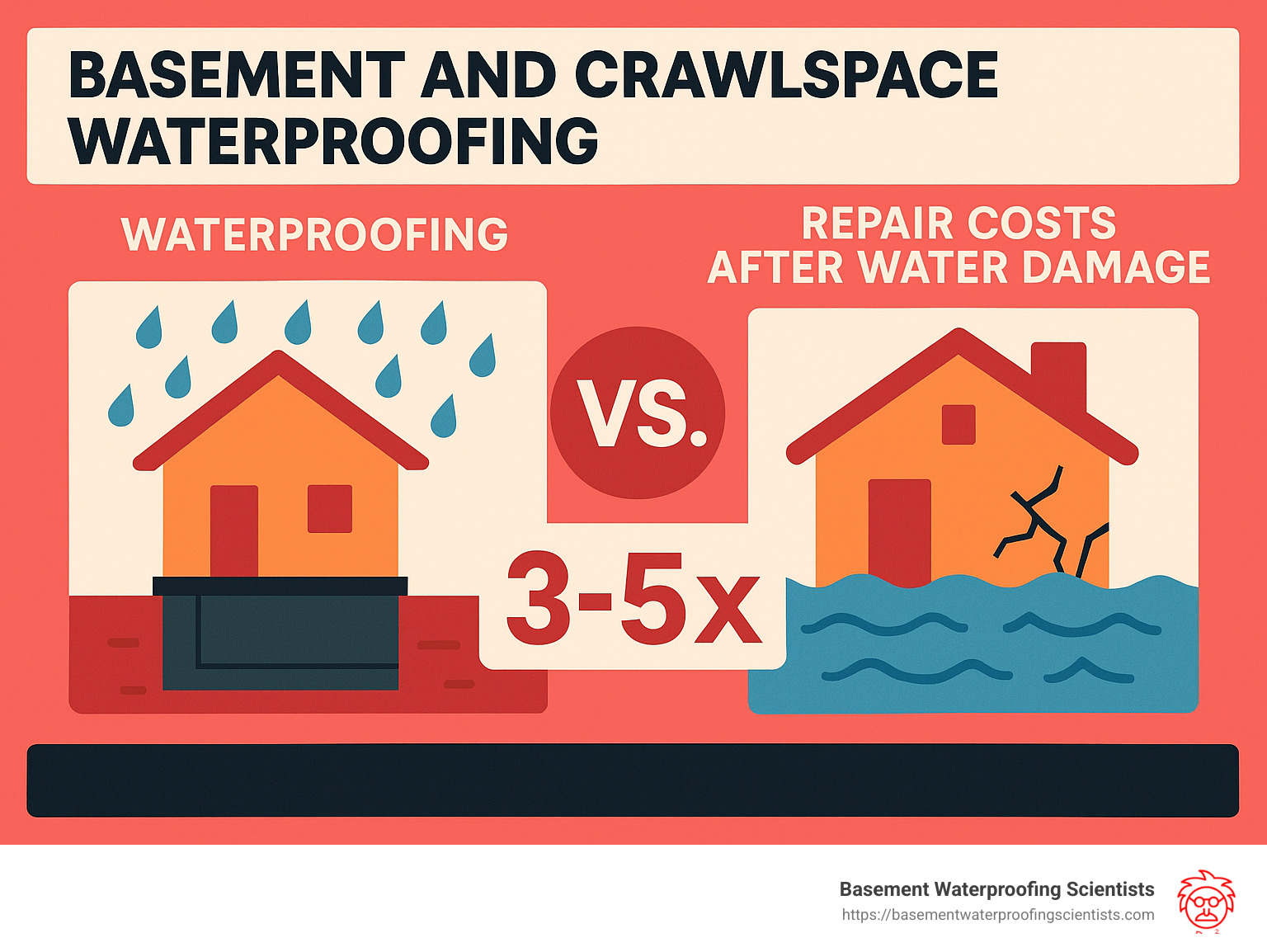
I’ll never forget the homeowner in West Chester who called us after getting six inches of water in his finished basement. “I knew I had a small leak for years,” he told me, “but I kept putting it off because of the cost.” That delay ended up costing him over $30,000 in restoration work, plus losing irreplaceable family photos and memorabilia.
This is precisely why we offer free inspections throughout our service area—identifying and addressing problems early saves both money and heartache in the long run. When it comes to water damage, an ounce of prevention truly is worth a pound of cure.
Frequently Asked Questions about Basement and Crawlspace Waterproofing
At Basement Waterproofing Scientists, we’re committed to helping homeowners across Pennsylvania, New Jersey, and Delaware make confident decisions. After 30 years of providing reliable, lasting solutions, we’ve heard just about every waterproofing question you can imagine. Here are clear, straightforward answers to some of the most common questions we receive about basement and crawlspace waterproofing.
Regular crawl space maintenance, including crawl space encapsulation, is crucial to mitigate moisture and odors, prevent mold or pest infestations, and ensure the overall health of your home.
What are the risks of not waterproofing my basement or crawlspace?
Neglecting moisture issues in your basement or crawlspace can quickly turn minor annoyances into major headaches. Persistent moisture can cause structural damage, weakening concrete, corroding metal supports, and rotting wooden beams and joists. Over time, these problems can escalate into costly repairs—think sagging floors, cracked walls, or even foundation failure.
Moisture also creates ideal conditions for rapid mold and mildew growth, which can appear within 24-48 hours. Mold can spread throughout your home via air ducts and HVAC systems, posing serious health risks for your family. Allergic reactions, asthma flare-ups, respiratory infections, and other symptoms are common consequences for children, the elderly, and anyone with health vulnerabilities.
Damp, musty conditions attract unwanted visitors as well. Pest infestations from termites, carpenter ants, rodents, and silverfish thrive in moisture-rich environments. These pests can further damage your home and belongings, escalating costs and frustration.
In addition, moisture issues significantly reduce your property value. Homeowners are legally required to disclose water problems to buyers, causing potential price reductions of 10-25%. Many clients tell us they regret waiting too long to address basement moisture. As one homeowner in Ardmore put it: “A small leak turned into a huge structural repair project. Instead of spending $5,000 on waterproofing early on, I waited and ended up with $30,000 in repairs.”
Waterproofing your basement or crawlspace now can prevent expensive damage, protect your family’s health, and preserve your home’s value.
How does climate and location affect the choice of waterproofing methods?
Climate and location play a big role in determining the best waterproofing approach. At Basement Waterproofing Scientists, we’ve seen how different regions throughout Pennsylvania, New Jersey, and Delaware face distinct moisture challenges requiring customized solutions.
For example, local soil types influence moisture behavior significantly. Clay-rich soils hold moisture longer and exert more hydrostatic pressure, pushing water through foundation walls. On the other hand, sandy soils drain quickly but might cause erosion issues around your foundation.
Local rainfall patterns also matter—regions like ours with seasonal heavy rains frequently require robust drainage solutions like interior drainage systems and sump pumps. Homes in areas with naturally high water tables typically face ongoing groundwater intrusion, even without surface flooding. They often need comprehensive solutions such as crawlspace encapsulation or exterior waterproofing membranes.
Additionally, our Northeast climate means frequent freeze-thaw cycles—water entering foundation cracks can freeze, expand, and worsen structural damage year after year. Building codes and regulations vary by location too, so choose waterproofing solutions that meet local standards.
In short, there’s no one-size-fits-all waterproofing approach. As our lead engineer often says: “What works perfectly in Reading might be inadequate in Philadelphia due to soil differences, groundwater levels, and rainfall patterns. That’s why we always customize our waterproofing solutions for your home’s unique location and needs.”
Can I waterproof my basement or crawlspace myself?
It depends! Some small tasks can certainly be tackled as DIY projects, especially if you’re handy around the house and the issue is minor. For example, homeowners often successfully handle gutter cleaning and maintenance, extending downspouts away from the home, and improving grading around their foundation. You might also comfortably seal small, non-structural cracks with hydraulic cement, apply waterproof paints for minor dampness, or operate basic dehumidifiers.
However, more comprehensive tasks involving structural concerns or extensive water intrusion typically require professional help. Installing interior drainage systems, sump pump systems (especially with battery backup), or performing exterior waterproofing with excavation are tasks best left to professionals. Crawlspace encapsulation and foundation wall reinforcements also require specialized equipment, materials, and technical expertise.
If your basement or crawlspace has recurring moisture problems or you’re seeing signs of structural issues like cracks or bowing walls, calling professionals ensures a long-term solution. As Laura G. from Collegeville shared with us after some unsuccessful DIY attempts: “I finally called Basement Waterproofing Scientists after spending a lot of time and money on products that didn’t work. They explained everything clearly and made sure we understood each step. The long-term peace of mind and warranty made it worth every penny.”
How long does professional waterproofing last?
The durability of your waterproofing solution depends largely on the methods and materials used. At Basement Waterproofing Scientists, we’ve spent decades refining our practices to ensure long-lasting results.
Interior sealants and waterproof paints, while less expensive, typically last around 2-5 years, depending on moisture levels. Crack injections can offer more longevity—polyurethane injections often last 5-10 years, while epoxy injections can last even longer if the foundation remains stable.
Interior drainage systems, when properly installed and maintained, typically offer 15-20 years of protection. Sump pumps generally last between 7-10 years, but battery backups usually need replacement every 3-5 years.
Exterior waterproofing membranes installed during excavation are very durable, typically lasting 15-25 years or more. Premium crawlspace vapor barriers (like the 20-mil materials we use) typically provide 25+ years of reliable moisture protection.
At Basement Waterproofing Scientists, we stand firmly behind our work with an industry-leading lifetime guarantee. That means as long as you own your home, you’re covered. It’s our way of giving you total peace of mind that your home will stay dry for decades.
Will waterproofing increase my home’s value?
Absolutely! In fact, real estate professionals consistently find that fixing moisture issues adds significant value when selling your home. A properly waterproofed basement or crawlspace improves your home’s marketability and typically returns 30% more than the initial waterproofing cost at resale.
Additionally, many homeowners choose to create livable space from previously unusable basement areas. Dry, finished basements add approximately $10-$25 per square foot in value, providing extra living space without adding to your home’s footprint.
Waterproofed homes also sell faster, since buyers are cautious about moisture issues. A professional waterproofing system becomes a valuable selling point during inspections, helping you avoid potential red flags or negotiation problems.
One of our clients in Royersford recently told us: “The waterproofing solution from Basement Waterproofing Scientists became a huge selling point when I put my house on the market. Buyers loved the transferable lifetime warranty and felt confident about making an offer.”
In short, a waterproofed basement or crawlspace pays dividends beyond just a dry home—it’s an investment that significantly boosts your home’s long-term value.
The Basement Waterproofing Scientists Difference
What makes Basement Waterproofing Scientists stand out is our commitment to truly understanding the root of your water problems. We don’t just slap a temporary fix on your walls and walk away. Instead, we take the time to:
-
Conduct a thorough inspection using state-of-the-art moisture detection equipment.
-
Create a customized waterproofing plan custom specifically to your home’s unique needs.
-
Perform expert installations using premium materials and proven techniques.
-
Test and verify the effectiveness of our work before considering the job complete.
-
Back every job with a lifetime guarantee for your peace of mind.
This methodical approach has earned us the trust and gratitude of thousands of homeowners across our service areas—including Philadelphia, Reading, Norristown, Pottstown, Bensalem Township, Upper Darby Township, Bristol Township, Middletown Township, Lansdale, Warminster Township, Springfield Township, Haverford Township, Radnor Township, Willow Grove, King of Prussia, Horsham, Exeter Township, Cumru Township, Ardmore, Bryn Mawr, Quakertown, Royersford, Conshohocken, Hatboro, and Collegeville.
No matter where you live, if water is getting into your basement or crawlspace, we’ve likely seen and solved a similar problem before.
Taking the Next Step
The hardest part of waterproofing is often just getting started—but here’s the reality: water problems don’t magically go away. In fact, they usually become more severe and costly the longer they’re ignored.
If you’ve noticed even minor signs of moisture—whether it’s damp walls, musty smells, or small puddles after rain—it’s time to take action. Not sure what’s causing the problem? That’s okay! We’re here to help.
We invite you to reach out today for a free, no-pressure inspection and estimate. Our experts will visit your home, carefully review your basement or crawlspace, and clearly explain what’s happening. We’ll use simple terms to help you understand exactly where water is entering and how we can fix it—affordably and effectively.
You’ll receive a detailed, transparent estimate and personalized recommendations based on your unique situation. Plus, our team is happy to answer any questions or address concerns you might have along the way.
Remember: the most expensive waterproofing is the one you have to do twice. With Basement Waterproofing Scientists, you’ll get a permanent solution done right the first time, backed by our lifetime guarantee.
Water might be stubborn—but we’re even more determined. With our expertise, advanced diagnostic tools, and proven waterproofing solutions, your basement or crawlspace can stay dry, healthy, and usable, no matter what Mother Nature decides to throw your way.
Ready to protect your home and family? Reach out to Basement Waterproofing Scientists today—we look forward to keeping you dry, comfortable, and worry-free for decades to come!


